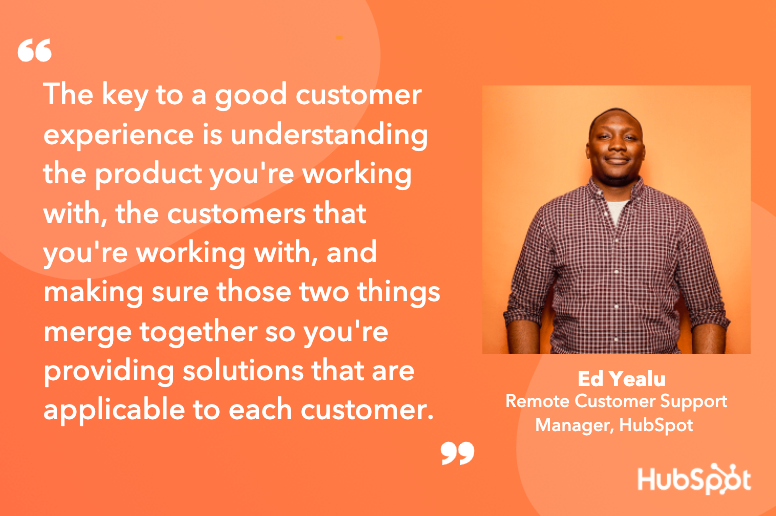Remote work can be a bit of a shock at first.
Most people don't realize how much they depend on the resources readily available in their office until they transition into a remote role. Management is immediately available to help, specialists can answer questions, and you can take advantage of your facilities' perks like its breakroom or gym. Even the personal, community interactions between you and your coworkers play an important role in your workflow. When you suddenly lose these subtle benefits all at once, it's easy to get knocked off track from your daily routine and lose a bit of your confidence.
If you're a customer support manager, overseeing a remote team can add to these challenges. You need to create an environment that addresses everyone's needs but also fosters a team culture that revolves around customer success. Balancing both can be tricky, especially when you don't have an office space to physically bring people together.
Access Now: Customer Support Strategy Template [Free Tool]
If your team is experiencing roadblocks like these, check out this interview from a podcast called, "The DNA of an Experience." Joe Martin, VP of CloudApp, interviews, Ed Yealu, a remote customer support manager from HubSpot. Yealu talks about the challenges of managing a remote customer support team and what he does to overcome those obstacles.
In this post, we'll recap Yealu's interview by rounding up some of his tips for managing a remote customer support team.
7 Tips for Managing a Remote Customer Support Team
1. Understand Solutions Rather Than Relaying Answers.
Yealu starts the interview by talking about the impact team culture has on remote support teams. Ed Yealu believes in creating a culture where frontline reps are "committed to understanding and relaying solutions, not just copy and pasting answers." This means his reps are looking for long-term, personalized solutions rather than quick fixes that shuffle the customer out of the support queue as quickly as possible.

Negative customer experiences are caused by reps not understanding the customer's goals, intent, and reasons why they're stuck. Yealu says that the key to a good customer experience is "understanding the product you're working with, the customers that you're working with, and making sure those two things merge together so you're providing solutions that are applicable to each customer." Understanding the differences between people and their problems is crucial when providing customer support.
2. Empathize With the Customer's Perspective.
Sometimes it can be hard to empathize with a customer when you're not working face-to-face with them. As a remote rep, you can't physically see a customer's emotions and they may not be expressing them openly if you're communicating through a text-based channel like live chat or email. Having this barrier between you and the customer makes it imperative that reps focus on putting themselves in the customer's position whenever they're troubleshooting a case.
Ed Yealu notes that most customers will do their due diligence before reaching out to your customer support team. When people make a call to support, it means they can't find an answer to a problem and they're probably tired of searching for a solution on their own. As Yealu puts it, "they're not calling support for you to take the journey with them. They're calling in so you can provide the destination."
"They're not calling support for you to take the journey with them. They're calling in so you can provide the destination." - Ed Yealu, HubSpot Customer Support Manager
The more reps can align with the customer's perspective, the easier it will be to provide an effective solution. They'll know what the situation is, why it's a problem for the customer, and what their options are for providing support.
3. Train Reps in Tertiary Support.
As a HubSpot customer support manager, Ed's team works with a lot of different tools that extend beyond the HubSpot platform. Since HubSpot's customers have access to an ecosystem of integrations, HubSpot support reps need to be ready to provide answers when customers want to know how to use HubSpot with other software. Yealu calls this type of support, "tertiary support" and believes it's essential for going above and beyond for a customer.
Here's an example that he gives in the interview.
HubSpot customers will often use HubSpot's website analytics tools alongside Google Analytics. While both tools offer customers unique insight into website data, each platform measures web traffic in different ways. Therefore, a HubSpot support rep needs to know how to advise a customer who's using both and has questions about any discrepancies.
Answering these questions that extend beyond your proprietary products shows both product expertise and an understanding of customer needs. It shows you not only know how to support your product but also where it fits in your customer's workflow.
4. Create an Office Ecosystem.
At one point in the interview, Yealu talks about the lack of "osmosis and proximity" on remote support teams. He says, "learning technology (or a product) is like learning a new language; the only thing that's going to make you fluid is being fully immersed in it."
At home, you don't have that same type of office ecosystem that surrounds your workday. You aren't physically in a collaborative space where you can turn to your colleague for support or discuss an issue related to your company. Over time, this makes it easy to lose focus and drift from team or company goals.
It's important as a remote manager to find activities and resources that can recreate an office environment. While you'll never fully replace in-person collaboration, you can provide communication outlets that embrace the differences of remote work.
For example, Yealu encourages his new hires to create their own Slack room. That way, this group has a judgment-free zone where they can perform "sanity checks" and ask questions without feeling like management is watching for mistakes. Even though they're not physically interacting in the same room, this encourages reps to openly communicate with each other, especially when they have questions about a support case.
5. Introduce Reps to Live Cases Immediately.
Some customer support teams delay giving new hires real cases to work with until they've completed training. Yealu believes that it's better to expose team members to what their daily workflow will look like early on in the onboarding process. That way, reps will know exactly what to expect from customers when their work is being measured against daily metrics.
Rather than spending the bulk of training on processes and logistics, frontline support reps should be involved in casework as early as possible. This will help them settle faster in the remote support role because they'll be challenged to find a workflow that suits their needs. It will also help you as a manager discover the different strengths and weaknesses that new hires have when starting on your team.
6. Utilize Documentation and Management Tools.
Yealu continuously emphasized the importance of utilizing management tools like documentation to "expand your bandwidth as a manager and the bandwidth of your team."
For example, when you're managing team members who work in different timezones, how available can you make yourself to your entire team? Since you don't have an in-office ecosystem to support everyday questions, you'll need an internal knowledge base to keep communication more organized. This resource database will help your employees find the answers they're looking for without having to navigate through a bottleneck to obtain information.
Yealu also notes that this self-service system stresses the importance of resource management and how reps should follow the research process. As a manager, you should explain what each internal and external resource is for and when each one should be used. You should also provide contingencies if one source doesn't answer a question or if the rep needs more information. This system trains reps to find their own solutions using a consistent process, which translates to when they're working with customers on support cases.
7. Focus on Group-Based Communication.
Yealu wrapped up the interview by talking about group-based communication and how it can build a strong team culture specifically with remote teams. He gave the example of group training and pointed out how this environment is generally more effective for training remote reps.
When your team is in one shared meeting instead of a bunch of individual one-on-ones, information gets shared more rapidly. Reps need this collaborative space where they can ask questions in a casual setting and receive an immediate response. And, since each rep perceives information differently, it can lead to interesting discussions and discoveries that team members may not have been aware of before.
For more tips on managing a remote team, check out Ed's full interview with Joe at the top of this post. If you're looking to go remote, read Joe Martin's tips for onboarding a remote customer support team. 
.png?width=112&height=112&name=Image%20Hackathon%20%E2%80%93%20Vertical%20(9).png)




![25% of Service Reps Don't Understand Their Customers [New State of Service Data + Tips]](https://www.hubspot.com/hubfs/companies-that-listen-to-their-customers-1-20241008-1837871-1.webp)





